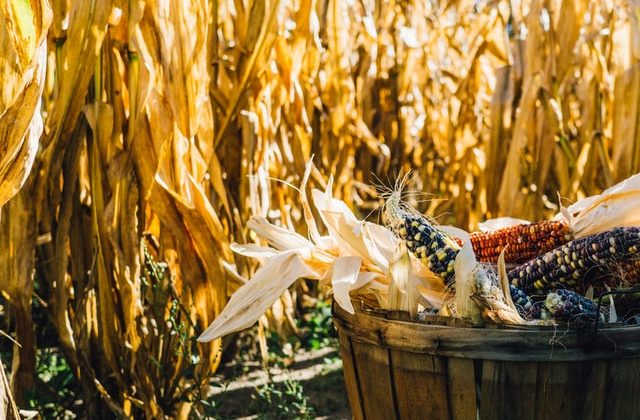Susan O'Rourke | September 30, 2021

As fall settles in, many teachers in the U.S. are gearing up to celebrate autumnal traditions and the Thanksgiving holiday with their students. Institutions like the National Museum of the American Indian and Plimoth Patuxet Museums and organizations like Learning for Justice (formerly Teaching Tolerance) have put together a number of resources for educators looking to dig deeper into the history of the holiday, the Wampanoag people, and the complex and diverse cultures of Indigenous cultures in the United States. UNC World View encourages you to check out the following resources centered on Indigenous voices and the importance of a harvest to communities across the globe as you prepare your upcoming lessons.
The National Museum of the American Indian
The National Museum of the American Indian has developed an excellent set of teaching resources that includes:
- Lesson plans and contextual essays
- American Indian Perspectives on Thanksgiving (Grades 4-8)
- Five Ideas to Change Teaching about Thanksgiving, in Classrooms and at Home
- Everyone’s history matters: The Wampanoag Indian Thanksgiving story deserves to be known
- Harvest Ceremony: Beyond the Thanksgiving Myth (Study Guide)
- A dialogue toolkit to help students reflect on inherited ideas and to build a more complex understanding of Indigenous cultures in the United States
- A video accompanying the digital exhibition Americans: The Invention of Thanksgiving
- A bilingual guide to a “Thanksgiving Activity for the Classroom | Actividad de Acción de Gracias para el aula”
Learning for Justice has also developed a series of articles and lesson plans that challenge simplified histories of Thanksgiving and bring greater attention to Indigenous cultures and struggles.
- Articles
- Teaching Thanksgiving in a Socially Responsible Way
- When Trivia Isn’t Trivial
- Teaching the Hard History of Indigenous Slavery
- Decolonizing the Classroom: Teaching With Indigenous Comics
- Lessons and Learning Plans
- Thanksgiving Mourning
- The History of Our Town (K-2 discussions of colonization)
Plimouth Patuxet provides insight into historical and archaeological work being done in the region through
- An online exhibition Echoes of the Ancestors
- The exhibition guide for History in a New Light: Illuminating the Archaeology of Historic Patuxetand Plymouth (PDF slides)
This time of year also presents an excellent opportunity for educators to globalize their curriculum and introduce students to harvest festivals around the world. Check out the resources below to help initiate discussions of global harvest festivals in your classroom.
The New Yam Festival
Celebrated in parts of the “yam belt” in western Africa, the New Yam Festival is a day of thanksgiving and a celebration of community, generosity, agriculture, and the arts. The celebration includes “sacrifices of thanksgiving at both the individual family and community levels,” the ceremonial preparation of the yam in each household, and “[clearing] footpaths to the community and streams,” and masquerades. Leaders also celebrate people’s economic and cultural contributions to the community. The festival is also celebrated in Papua New Guinea.
Sources:
- The New Yam Festival: A Celebration of Life and Culture (Google Arts & Culture)
- The site includes images from celebrations and focuses on traditional dance and fashion.
- From the Mound to the Square: The Impact of the New Yam Festival on the OgojaPeople (Patrick O. Odey in African Identities)
- 5 Harvest Festivals Around the World (Britannica)
Chuseok
Celebrated in Korea, this harvest festival takes place on the 15th in the 8th month in the lunar calendar. Over the holiday, many people travel home to be with their families. When together, “families traditionally start the day’s festivities with a memorial service known as charye which commemorates their ancestral heritage with enough songpyeon (half-moon rice cakes) for everyone to enjoy.” The three-day holiday is filled with dancing, music, and traditional games like yut,
Sources:
- Chuseok: Korean Thanksgiving Day (Asia Society)
- Chuseok 2021 Doodle
The Homowo Festival
Celebrated in the Accra region of Ghana, the Homowo Festival commemorates a time of renewed abundance. The festival recalls the trials the Ga people experienced when they first arrived in the Accra region after leaving Nigeria in the 17th century. Faced with famine, the Ga people “fasted and prayed, then began farming [maize] and had an excellent crop.” Thus, a maize dish, kpoikpoi (also called kpekple) is one of the centerpieces of the celebration. The festival provides an opportunity to celebrate the Ga people’s cultural heritage and ability to overcome challenges—both historical and contemporary. The celebration, which typically takes place in August, includes parades, meal sharing and celebrations of community across towns.
Sources:
